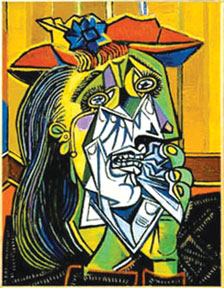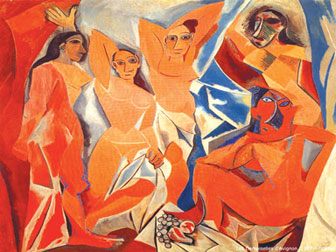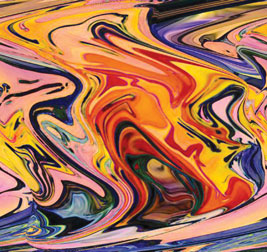How to appreciate abstract art
By Shireen SENADHIRA
 In its basic form an abstract art, in western art, is one without a
recognizable subject, one which doesn't relate to anything external or
try to "look like" something. Instead colour and form are which matter.
It is completely non-objective or non-representational. In its basic form an abstract art, in western art, is one without a
recognizable subject, one which doesn't relate to anything external or
try to "look like" something. Instead colour and form are which matter.
It is completely non-objective or non-representational.
In contrast, landscape art depicts natural scenery such as mountains,
valleys, trees, rivers, forests and especially art where the main
subject is a wide view with its elements arranged into coherent
composition. The sky is almost always, included in the view.
This earliest form of such art are frescoes from Minoan Greece about
1500 BC. Hunting scenes and vistas set in enclosed reed beds of the Nile
Delta of Ancient Egypt give a strong sense of place. A rough system of
perspective and scaling for distance needed for whole landscape scenes
appear in literary evidence in Ancient Greece in the Hellenistic period,
but no large scale examples of such art exist any longer. There's more
art survival from Ancient Roman art from the 1st century BC and thereon.
These are of frescoes of landscapes decorating rooms and these have been
preserved at Pompeii and Herculaneum.
The Chinese ink painting of mountain and water where the only sign of
human life is, generally, a sage or a glimpse of his hut. This art arose
about the 8th century AD. In East Asia, the classic Chinese
mountain-water ink painting was the most prestigious form of visual art.
The industrial revolution of Europe and the declination of official
patronage in the East, as well as the development of museums and
galleries, mostly in the West, made the role of the artist less defined.
The objects that artists fashioned then joined the general flow of
commodities in a market economy. In spite of this, the avant garde
artists refused to produce art work as cultural commodities. The artists
of the 1943 Group of Sri Lanka (Ceylon then), were a good example of
such avant garde artists.
Though there was no dearth of artistic talent in Sri Lanka, no other
avant garde movement except the 43 Group ever banded together. A reason
for this stagnation of art could have been the absence of a proper
museum or galleries of contemporary art.
 Since mid 20th century, the passion for landscapes headed towards
abstraction. The break from the notion that a painting had to represent
something, took place at this time. As a subject, landscapes provided
entry into abstraction easily. Beneath the landscape rolling grass and
top soil lies hard rock, a geological level. This becomes a parallel
between literal depiction of appearance and the painting of deeper
levels of significance. Since mid 20th century, the passion for landscapes headed towards
abstraction. The break from the notion that a painting had to represent
something, took place at this time. As a subject, landscapes provided
entry into abstraction easily. Beneath the landscape rolling grass and
top soil lies hard rock, a geological level. This becomes a parallel
between literal depiction of appearance and the painting of deeper
levels of significance.
Peter Lanyon's abstract art matured as he developed earthy yet mystic
landscapes. The emphasis was kept not on personal emotion but of a
deeper harmony derived from nature. His painting, the 'Lost Mine' is a
good example of Lanyon's abstract art. This painting looks effortless
with no identifiable skill but it is not so. Lanyon also wanted to
anchor his painting to specific places, events and feelings. This
painting is of blue swirls with grey-black strokes enmeshed in it. There
are spots of white and a splash of red too. The source of the painting
was a disaster, the flooding of a tin mine by the sea in Cornwall. It
seems as if the scene is viewed aerially through cloud cover. There is a
sense of mangled machinery (the grey-black strokes), swirling water
(blue swirls) and immediate danger which one might miss with a cursory
glance at it.
Impressionism, Fauvism (like Matisse, from the beginning of the 20th
century, who viewed painting as a two dimensional decoration in colour,
not necessarily imitative of nature), Cubism and other art movements at
the time, contributed to break the principles of art followed since the
renaissance. Impressionism made artists "not finish" their paintings.
The Fauvists used colour in a non-realistic way. Cubism was the idea of
painting an object from more than one angle. In this way, art work
evolved so that colour, line form and texture became the "subject" of
the painting. Abstract art which emerged in the 20th century applied
principles of expressionism to abstract painting. This was followed by
Action Painting. Some examples of the latter like that of Pollock's, had
art work in which paint was dripped, dropped, smeared, splattered or
thrown on the canvas.
 The 43 Group of Sri Lanka had as its chief, Lionel Wendt, an
excellent photographer, and the painter, Harry Pieris as his secretary.
The group was founded in Colombo as a reaction against the officially
supported Victorian naturalism and artistic sterility of the Ceylon
Society of Arts. However, Lionel Wendt died young and the group was
sustained by Harry Pieris. A great contributory factor in the genesis of
modern art movement in Sri Lanka was C F Winzer from 1920. He was
employed by the Department of Education, as the Chief Inspector of Art.
His aesthetic ability, his familiarity with good art, his wide
understanding and his awareness of new developments in art education
enabled him to lay new foundations toward a more vibrant and vital
display of art. Winzer with Lionel Wendt stimulated and encouraged
genuine talent from in and out of school art. The 43 Group of Sri Lanka had as its chief, Lionel Wendt, an
excellent photographer, and the painter, Harry Pieris as his secretary.
The group was founded in Colombo as a reaction against the officially
supported Victorian naturalism and artistic sterility of the Ceylon
Society of Arts. However, Lionel Wendt died young and the group was
sustained by Harry Pieris. A great contributory factor in the genesis of
modern art movement in Sri Lanka was C F Winzer from 1920. He was
employed by the Department of Education, as the Chief Inspector of Art.
His aesthetic ability, his familiarity with good art, his wide
understanding and his awareness of new developments in art education
enabled him to lay new foundations toward a more vibrant and vital
display of art. Winzer with Lionel Wendt stimulated and encouraged
genuine talent from in and out of school art.
The Group thrived in modern art and was as follows:
Manjusri, a founder member of the group made outstanding
contributions to the preservation of national treasures by bringing
forth national awareness of their importance, in artistic as well as
historical terms. Inspired by surrealism and cubism, Manjusri also
created visual equivalents for the fantasies of the subconscious mind.
George Keyt, a very well-known artist, brought to the canvas the
opulent splendours of the world enhanced by the play of light and
perspective. Later his paintings were lines arabesque and pure colour
harmonies. His art was described as an art of "alankara" or "making
beautiful."
Richard Gabriel created abstracts, imaginary space like that of the
Primitives or native art. He made objects overlap as in Egyptian reliefs
and envelop each plane in an arabesque within a two dimensional
perspective. This was seen in the large scale church murals he painted.
Many of his paintings function as pictographs where figuration and
graphic elements are combined. His semi surrealistic paintings with
bulls, horses, dogs and crows are shown in various paintings symbolizing
cruelty, violence, sexuality, spiritual aspiration and man's
separateness and integration with the animal world.
William Beling was fascinated by the pictorial innovation of cubism
developed by Braque and Picasso. His landscapes were admirably
constructed with the endless variety of greens seen in tropical nature.
His figures were more angular than that of Keyt and of less movement.
After Winzer departed from the island, Beling assumed duties as the
Chief Inspector of Art in the Department of Education.
Ivan Peries's art is of a purely meditative paintings of his
indigenous experience. Peri's pictures are quite static. Whatever
movement there is, it is an internal kind of inner spirit of space. This
spirit, shown sometimes dramatic, violent, sometimes quiet, gentle and
delicate, almost musical, is the most profound feeling his paintings
display. The figures in his paintings are not much than objects for
particular arrangements of form and colour. The figures in his later
pictures are often faceless, robed silhouettes rather than identifiable
people. These have a mythological effect because they deal in a kind of
visual symbolism that generates its own meanings and allusions. Also,
their reality has been pitched at a point of mystery, understandable
only in their own pictorial terms.
Miguel Cervantes said that, once, a painter busy with his brush and
canvas was asked what he was painting and the reply was whatever it
turns out to be." This is the style of Harry Pieris" paintings,
especially his portrait paintings. He wanted to create a work of art and
verisimilitude was not his goal.
Justin Deraniyagala' images visualized an inner world. Rhythm and
patterns arose independently of the object while the object itself
merged unwilled as it were out of a dance of line and colour across the
canvas. His images seemed to grow out of the blur and flow of the paint
itself.
George Claessen' pictures carry a slow message in their simplicity.
He painted in different media, oils, watercolour, pastels and gouaches.
When he migrated to Australia, he experimented with pure abstraction
which later developed strongly into a style of mystic luminosity.
Aubrey Collette was best known as a cartoonist. There was biting
humour in his brilliant line work. His work not only brought out the
personality quirks of those whom he caricatured but also tapped
universal foibles they symbolized. The 43 Group has been immortalized by
his portrait sketches of the members.
With such attributes as seen from the above, it is no surprise that
some of the artists of the 43 Group brought international acclamation to
paintings in Sri Lanka. William Graham wrote of them: The most
significant movement in Eastern Art today is to be found in Ceylon (Sri
Lanka), Its importance lies in the synthesis of traditional art forms
and those deriving from the West, which has produced painting truly
eastern in inspiration, yet of universal validity. Its great vitality
springs from a contemplative humanist vision, which gives an imaginative
and lyrical interpretation of the life of the island; It is an art at
once profound and optimistic.
There is also much to be admired of the other artists and the younger
generation of artists in Sri Lanka. Their range of content in this genre
of modern art extends from sensual depictions, expressionist existential
depictions, abstractions, to representations of trees and ephemera. In
all these works, the varied and personal tendency in contemporary art is
shown as well as the eclecticism, from ever changing features of modern
art.
However, if a piece of abstract art is to have significance for
anyone other than the artist, it needs to attract the viewer and retain
his or her attention. It has to draw the viewers in, keep them looking
and generate an emotional response.
A few hints to view abstract art:
* allow yourself to let something emerge from the painting rather
than figure out what it looks like or represent.
* look for the elements, colour and texture of the painting and how
they interact with each other.
* what emotions are evoked when looking at the painting? * look at
the title and see how it influences what is viewed.
* give enough time to make a connection with the painting.
It was Wassily Kandinsky, the famous abstract painter who said:
Of all the arts, abstract painting is the most difficult. It demands
that you know how to draw well, that you have heightened sensitivity for
composition and for colours, and that you be a true poet."
|

